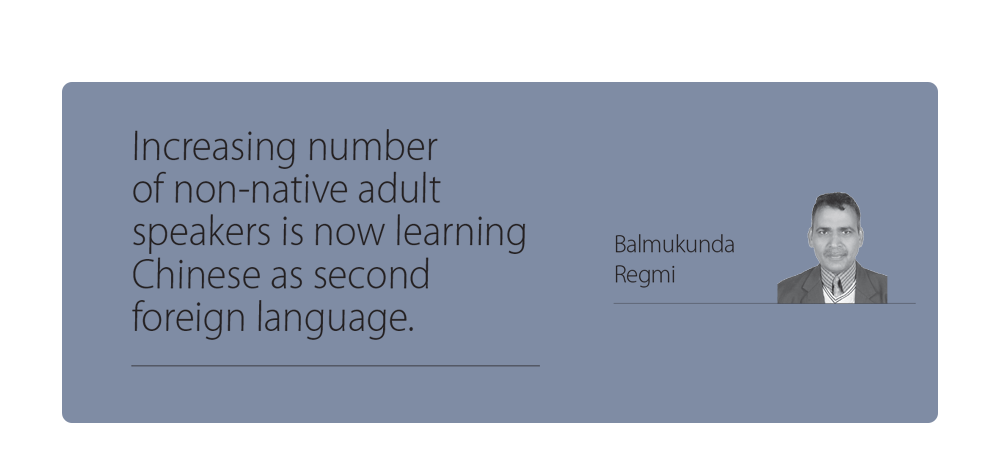- Sunday, 15 June 2025
Growing Influence Of Chinese Language
Recently Chinese economy has made fast growth. Its share of global economy has increased to 16.3 per cent for the year 2019 from 2.3 per cent in 1980, as per the World Bank estimates. Such fast pace of China’s economic growth has attracted global discussions, and many are trying to understand and mimic the Chinese model of development. This write-up tries to see whether the Chinese language is earning a global promotion associated with the economic growth of China (including Taiwan, Hong Kong and Macao), Singapore and Malaysia which has a significant Chinese population.
As of 2021, their combined GDP is estimated to be around $24.5 trillion, which represents approximately around $24.5 trillion or 29 per cent of the world's total GDP, according to World Bank data. In 2019, it was about $20.5 trillion or 24 per cent. Although they have distinct differences in pronunciation, grammar and vocabulary, Mandarin, Cantonese, Wu, Min, Hakka and several others are considered one language, various dialects and languages in the Chinese language family share some similarities in terms of grammar and vocabulary.
Simplified version
Sometimes the dialects are not mutually understood when spoken, but they are understood when written. The difference between the old characters in use in Taiwan and Hong Kong versus those simplified characters in use in Mainland China and Singapore does not make these writings distinct scripts; the simplified version maintains recognisable one-to-one relation with the traditional characters.
Putonghua or Standard Chinese, largely based on Mandarin, was introduced in the 1930s and 1940s. It was adopted as the official spoken language of the People's Republic of China in 1955. As a mother tongue, it is also the most widely spoken languages in the world, with over 1 billion speakers. Cantonese is another major Chinese language, primarily spoken in the southern regions of China, particularly in Hong Kong and Macau. It is also spoken by many Chinese communities around the world.
Unlike Hindi which has not been able to appear as a single lingua franca in its own country India, Putonghua has successfully become single lingua franca in China. Such development has enabled it in projecting itself as the single Chinese language in the international stages. As the official spoken language of China, the Putonghua (hereafter mentioned simply as Chinese) is rapidly gaining momentum both inside China and abroad. Increasing number of non-native adult speakers is now learning Chinese as second foreign language.
Though exact data are unavailable, many primary and secondary level students around the globe are learning Chinese as first or second foreign language. This indicates Chinese is being widely accepted as second foreign language. With the resurgence of China as a major world political and economic power, Chinese language has also received state support in its global propagation. Chinese International Education Foundation states, as of the end of 2019, there were 550 Confucius Institutes and 1,172 Confucius Classrooms in 162 countries and regions around the world.
Since the beginning of the Confucius Institute programme in 2004, with the support of the Chinese Ministry of Education-affiliated Hanban, renamed in 2020 as Centre for Language Council International, it has provided services for tens of millions of students from various countries to learn Chinese and understand Chinese culture. It has helped significantly promote the development of international Chinese education. Until as late as the year 2000, in terms of non-native speakers, Chinese ranked the eighth, and came after English, French, Arabic, Portuguese, Russian and German.
A British Council's report titled "Languages for the Future: Which languages the UK needs to become a truly global nation" mentions that the number of non-native speakers of Putonghua was estimated to be over 100 million worldwide, making it the second most widely learned language after English. This marks a significant increase from the past, where the number of non-native Chinese speakers was relatively small compared to other major world languages. Until 1990 when China was the seventh largest but rapidly expanding economy, few believed that it would become second largest economy in a matter of 20 years. Now the International Monetary Fund projects China to surpass the US as the world's largest economy by 2028.
Similar phenomenon may or may not happen with the language. English got globalised as a result of the expansion of the British empire. When the Great Britain shrank, the US became the world leader, which again provided favourable environment to the growth of English. How the power matters in the propagation of a language is best seen in the increasing use of American spellings in global English. In a sense, Chinese language has already been globalised. Plurality of international lingua franca was accepted when the UN adopted Arabic, Chinese, English, French, Russian and Spanish as its official languages.
Research achievements
See how English has become the major language of information generation and propagation. English is the language in which most of the research achievements are published. Science Citation Index (SCI), Social Science Citation Index (SSCI) and Art & Humanities Citation Index (A&HCI) are three major indexes in the world. SCI covers 106 academic disciplines including physics, medicine and computers. SSCI covers 25 academic fields such as language, society, geography, politics and communication. A&HCI covers 14 academic fields such as philosophy, literature, architecture and theology.
Based on 10 years data from 2010 to 2019, Rao Gaoqi and colleagues say, English texts accounted for 98 per cent of SCI, 96 per cent of SSCI, and 75 per cent of A&HCI papers; whereas Chinese ranked fourth, twenty-second and tenth, respectively. A close look shows something different; many non-native English writers contributed to making English a major language of publications. For example, of 98 per cent SCI papers, the contribution of American scholars stood at 28 per cent, and that of Chinese scholars was 17 per cent.
Future will show whether China will try to make more SCI publications in Chinese, and whether such measures will succeed. It is also possible that Chinese may first become a popular international social language allowing English lead in SCI publications, comparable to what English had done with Latin. As to Nepal, an immediate neighbour, promotion of Chinese as a global lingua franca may bring some spill-over benefits.
(Regmi is a professor at Tribhuvan University and a researcher at Charhar Institute, China)
















